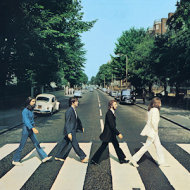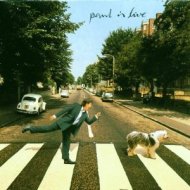That coverPrior
to 1969, if you had insisted that a crosswalk would go down in history,
you might have found yourself in the crosshairs of a petition for
institutionalization. But a casual photo shoot on the morning of August 8
of that year made an otherwise nondescript pedestrian walkway into the
stuff of legend... and a peculiar destination for millions of tourists
to come.
It was 44 years ago this week that John, Paul,
George, and Ringo put on their walking shoes — well, three out of the
four of them, anyway — and stepped outside the Abbey Road Studios where
they were recording Abbey Road to take a rather determined stroll across... Abbey Road.
 A policeman briefly stopped traffic, so that there would be no need for a reenactment of Dustin Hoffman's "I'm walkin' here!" complaint from Midnight Cowboy.
But although you might imagine such an iconic cover was art-directed to
within an inch of its life, this was hardly an elaborate shoot.
Standing on a stepladder, photographer Iain Macmillan
took just a handful of shots of the band walking across the lane before
the Fabs got back to work. In only one of them did all four Fabs appear
to be strolling in symmetry, so it wasn't a tough choice.And yet more
has been read into this spontaneous image than perhaps any other album
sleeve in history.
A policeman briefly stopped traffic, so that there would be no need for a reenactment of Dustin Hoffman's "I'm walkin' here!" complaint from Midnight Cowboy.
But although you might imagine such an iconic cover was art-directed to
within an inch of its life, this was hardly an elaborate shoot.
Standing on a stepladder, photographer Iain Macmillan
took just a handful of shots of the band walking across the lane before
the Fabs got back to work. In only one of them did all four Fabs appear
to be strolling in symmetry, so it wasn't a tough choice.And yet more
has been read into this spontaneous image than perhaps any other album
sleeve in history.
Now it's been 45 years, and that
cover probably still sits in more frames than any other LP jacket. It
doesn't hurt that about a third of all rock fans over the age of 40
would probably name Abbey Road their favorite album of all time
regardless of what cover imagery it bore. But that textless image
surely has a lot to do with how Abbey Road remains the top-selling vinyl album in America almost every year, even now. (In 2012, it was knocked out of the top spot by Jack White's Blunderbuss, after being the No. 1 LP for three consecutive years prior to that.)
Just imagine how much less popular the album might be if it had bore its working title — Everest,
after a brand of cigarettes — and if, for the jacket art, they'd
followed through on the original hokey idea of traveling to the
Himalayas.
Instead, McCartney,
who was largely driving the creative bus in the band's last days, came
up with a simpler and decidedly more local idea, drawing a sketch "with
four little stick men crossing the zebra," studio historian Brian Southall recently recalled to the BBC.
A less iconic outtake that sold at auctionIn
1989, photographer Macmillan recalled the shoot for the Guardian: "I
remember we hired a policeman to hold up traffic while I was up on the
ladder taking the pictures. The whole idea, I must say, was Paul
McCartney's. A few days before the shoot, he drew a sketch of how he
imagined the cover, which we executed almost exactly that day. I took a
couple of shots of the Beatles crossing Abbey Road one way. We let some
of the traffic go by and then they walked across the road the other way,
and I took a few more shots. The one eventually chosen for the cover
was number five of six. It was the only one that had their legs in a
perfect 'V' formation, which is what I wanted stylistically."
You can thank Apple art director John Kosh for the textlessness. "I
insisted we didn't need to write the band's name on the cover," he said.
"They were the most famous band in the world after all," although "EMI
said they'd never sell any albums if we didn't say who the band was. But
I got my way, and got away with it."
The "Paul is dead"
mystique is less a part of the cover's allure than it used to be,
thanks to the passage of time, and the increasing unlikelihood that a
deceased McCartney was replaced by a ringer some time prior to Revolver without
Ringo ever stooping to admit the ruse. But it all seemed so significant
once upon a decade, starting with the license plate that had placed on
that Volkswagen Beetle to hint to the world that Paul would be 28 years old IF he had survived. (McCartney was actually 27 at the time, but why quibble?)
Paul was also the only one of the four to be leading with a different
leg than the others — a sure sign that he was "out of step" by virtue
of having shuffled off this mortal coil. And he was holding his
cigarette with his right hand, even though he was a legendary lefty —
easy proof of impostor-hood! John, in all-white, was clearly the
minister at the funeral; Ringo, in black, a designated mourner, or maybe
pallbearer (bands always make the drummer do the heavy lifting);
jeans-clad George, obviously the grave digger. Paul himself was
barefoot... and because some cultures bury their dead without shoes...
could it have been any clearer, even if some people didn't also see a
tell-tale skull embedded in the shadows of the back cover?
In fact, in some of the outtakes, Paul
was wearing a white pair of sandals, before he fatefully kicked them
off. A print of one of these unused shots, which actually portrayed the Beatles
walking the other direction (talk about fans having their world turned
upside down!) sold in an auction last year for 20,000 pounds, or well
over $30,000.
If there was any real symbolism at all in the cover, of course, it
was that the chosen imagery did have the band walking away from the
studio where they'd made virtually all their recordings. They were
recording their final album together, and when they would do an overdub
session for "I Want You (She's So Heavy)" three days later, it would
mark the last time all four of them were ever in the studio together.
(Three of them would reunite five months later, in January 1970, to do a
bit of patch-up work for the Let It Be album.)
Paul wasn't dead, but the Beatles effectively were. So maybe this was a funeral procession after all.
Yet there's nothing gloomy about the album art, if you aren't looking
for cryptic clues. If anything, the cover's sun-washed setting belies
the optimism of Harrison's "Here Comes the Sun." Surely many of the
tourists who come to London to have their picture taken crossing that
same street have had to extend their stay a few days, waiting for the
rain to lift so they can duplicate the weather as well as the setting of
their favorite cover.
How does it still entrance us today?
For starters, the Abbey Road crossing is one of the few in the world that has music buffs regularly checking in to its live web feed: http://www.abbeyroad.com/Crossing.
If you ever wanted to see a few dozen tourists an hour almost get hit
by a car, this is the site for you. "Someone's going to get mown down
one of these days, there's no doubt about it," a cab driver told the
BBC. But, as London's Guardian newspaper cheekily observed, "It could be
worse, of course. Think of the carnage if they had named their album
Oxford Street or M4."
Souvenirs of the shoot are hard to come by. Fans used to steal
variations on the street sign on the back cover with clockwork
regularity, so subsequent replacements have long been placed out of
reach. The Volkswagen on the cover sold at auction in the mid-1980s for
2,500 pounds, which seems like a steal compared to the astronomical
amount it could probably go for today.
The man seen standing in the background of the photo, Florida
resident Paul Cole, died in 2008 at age 95. Four years prior to that, he
was tracked down by Scripps and told how he came to accidentally be
part of one of the most famous photos of the previous century. "I told
(my wife), 'I've seen enough museums... I'll just stay out here and see
what's going on outside. I like to just start talking with people. I
walked out, and that cop was sitting there in that police car. I just
started carrying on a conversation with him... I just happened to look
up, and I saw those guys walking across the street like a line of ducks.
A bunch of kooks, I called them, because they were rather
radical-looking at that time. You didn't walk around in London
barefoot." It was when his wife was learning to play "Something" on the
organ a year later that he recognized himself on the cover. "I had to
convince the kids that that was me for a while. I told them, 'Get the
magnifying glass out...'"
"Paul is Live," with sheepdog. But the most celebrated parodist of all is a self-parodist: Paul McCartney, who returned to the scene of the crime for the cover of Paul is Live, a concert recording.






No comments:
Post a Comment